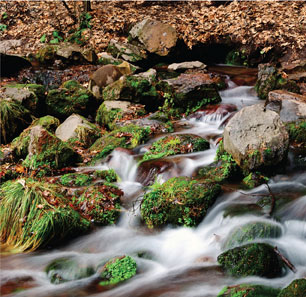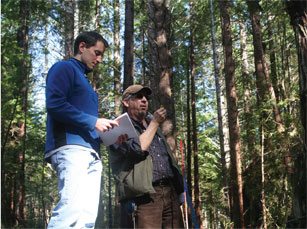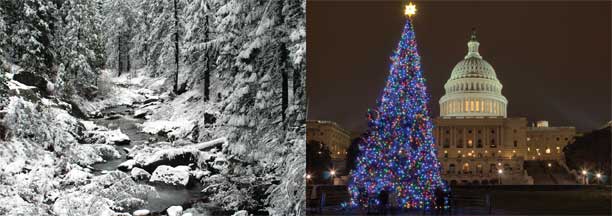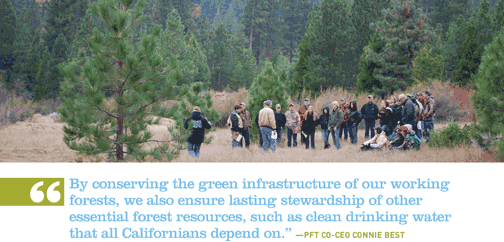
Spring 2011
“Forests: Where Our Water Comes From. PFT Expands Conservation of Key Watershed Regions, from Mt. Shasta Headwaters to Sierra Valley, California.”
Inside this Issue:
- Top of the Tap – Conserving Klamath-Cascade Watersheds
- Help Deliver Gift of the ‘People’s Tree’
- 2011: A Year for Forests
- Forests: Where Our Water Comes From – PFT Expands Conservation of Key Watershed Regions, from Mt. Shasta Headwaters to Sierra Valley, CA
- Mt. Shasta Headwaters – New Partnership Forged
- Sierra Valley – Key Watershed Lands Conserved
- Carbon Project Standards Approved in CA
- A Vision for ‘America’s Great Outdoors’ – Public-Private Partnerships Key to Landscape-Level Conservation, Report Notes
Top of the Tap – Conserving Klamath-Cascade Watersheds
Water. It’s the “source of life.” It can make or break a culture, a nation, even a planet. Wars are fought for it; poems laud and lambaste it. Whether you are a Seattle rain rabbit or a Mojave desert rat, you can’t live without water. In this issue of ForestLife, we highlight two Pacific Forest Trust projects designed to help safeguard the primary water fountains of the west: its forest watersheds.
More than 75 percent of California’s water flows from its forests. Collectively, these complex ecosystems clean, store and transport more water than all the treatment plants, dams and channels we have built for these purposes. Yet investment directed to conserving and restoring the forests that safeguard our water reserves is minute compared to the billions that have been spent on construction and upgrades of such man-made facilities. The consequences are dire, for if we continue to convert and degrade these forest watersheds, we endanger our very fountains of life. PFT has identified the Klamath-Cascade Region as a key area for conservation because of the significant role it plays in collecting, cleaning, storing and delivering water to over 22 million Californians. This area is a virtual “top of the tap” for California’s water supply.
Last year we convened the Klamath-Cascade Advisory Council, comprised of local landowners, state and federal agency staff, conservationists, biologists, ecologists, foresters and others concerned with the future of Klamath-Cascade lands and livelihoods. They guide our work in the region, complementing efforts to implement recommendations in PFT’s forthcoming Klamath-Cascade Greenprint for the Future. The Greenprint outlines a collaborative road map towards a sustainable 21st century resource–based future, grounded in the conservation of this remarkable landscape.
Learn more about PFT’s efforts to ensure the Klamath-Cascade’s vital watersheds don’t “run dry” on pages 4–8, where we highlight exciting conservation progress in the Mt. Shasta Headwaters and Sierra Valley.
“When forests are lost, we lose the water, air and other services they provide, as well as the human cultures and economies they support.”
—PFT President Laurie Wayburn, from the Jan. 28, 2011 Sacramento Bee
Help Deliver Gift of the ‘People’s Tree’
It might seem a bit early to be reading about Christmas trees—unless the tree in question is that iconic symbol of the giving season that will illuminate the U.S. Capitol Building West Lawn this December.
The Stanislaus National Forest in California’s central Sierra Nevada Mountains recently was announced as the official provider of this year’s Capitol Christmas Tree. The Pacific Forest Trust is proud to play a key role as well, by coordinating donations of services and funds that will be used to ensure delivery and presentation of the tree around various California communities and to our nation’s capital.
“The Capitol Christmas Tree is a gift from the state of California to all Americans,” said Maria Benech, Capitol Christmas Tree Coordinator for the Stanislaus National Forest. “Given all PFT has done for forests in the Pacific Northwest and California, it seemed very appropriate to partner with them to bring this symbol of U.S. Forests to the Nation’s Capital.”
“Holiday trees and evergreens are the closest many people get to our vital forests all year round, so it’s a privilege to help support this special celebration with the U.S. Forest Service,” added PFT President Laurie Wayburn.
Since 1970, it has been an honor for one of the National Forests to be asked to provide the Capitol Christmas Tree, star of the annual Capitol Christmas Tree Lighting Ceremony. Known as “The People’s Tree,” the conifer to be selected will be approximately 60-feet-tall—imagine a 6-story tall building—and will be transported back east on a semi-truck, resting on a custom built cradle that supports the branches and prevents damage while maintaining the tree’s perfect shape. A second truck will transport the tree’s 7,000 handmade ornaments and 100 companion trees, which will be placed in federal and Congressional offices as well as the U.S. Supreme Court.
A caravan of vehicles, including law enforcement, will escort the celebrated tree on a 8-day tour of California before it begins its 12-day journey to Washington, D.C.
For more information about how you can help send this very special “People’s Tree” to Washington, D.C., visit www.capitolchristmastree2011.org.
2011: A Year for Forest
 Forests are in the public eye this year, thanks to a recent United Nations’ proclamation of 2011 as the “International Year of Forests.”
Forests are in the public eye this year, thanks to a recent United Nations’ proclamation of 2011 as the “International Year of Forests.”
Here at PFT we decided to kick off this Year of Forests with an opinion piece that reminds Californians of the myriad ways we depend on forests, as well as the needs and opportunities we have to capitalize on the conservation momentum created by the state’s landmark climate legislation due to take effect in 2012.
In a Sacramento Bee op-ed published Jan. 28, PFT President Laurie Wayburn recognized the essential role forests play as watersheds and much-needed sources of jobs and revenue for rural economies. Read the article and link to other Year of the Forest resources offered by the U.S. Forest Service on our blog: http://bit.ly/UNForests2011.
Forests: Where Our Water Comes From
PFT Expands Conservation of Key Watershed Regions, from Mt. Shasta Headwaters to Sierra Valley, CA
 The casual forest observer may not realize they are looking at one of the most sophisticated water collection, storage, treatment and delivery systems on the planet. No chemicals, machinery or engineering is required to make it work. Quietly, these low-tech ecological wonders—our forests and woodlands—collect rain and snow, serving as natural reservoirs that release water into innumerable seeps, mountain meadows and streams. Purified as they tumble over rocks, falls and forest roots, those streams feed into larger creeks and rivers that supply our reservoirs, agricultural canals and water tables before wending to the sea.
The casual forest observer may not realize they are looking at one of the most sophisticated water collection, storage, treatment and delivery systems on the planet. No chemicals, machinery or engineering is required to make it work. Quietly, these low-tech ecological wonders—our forests and woodlands—collect rain and snow, serving as natural reservoirs that release water into innumerable seeps, mountain meadows and streams. Purified as they tumble over rocks, falls and forest roots, those streams feed into larger creeks and rivers that supply our reservoirs, agricultural canals and water tables before wending to the sea.
Scientists understand this relationship between forests and the most basic of human needs. But most Americans are unaware of the connection between forests and water supplies, according to recent polls conducted by The Nature Conservancy. Approximately 77 percent of U.S. residents could not accurately identify the natural origins of water used in their homes. More than half of those surveyed declined to even venture a guess.
“In the United States, we have the luxury of not having to know where our water comes from, and that luxury has created a disconnect between people and nature,” says Jeff Opperman, senior freshwater scientist at The Nature Conservancy. “As far as many Americans can tell, their water comes from the tap.”
While our public agencies may be more familiar with the connection between forests and our water supplies, it is often overlooked when local officials, policymakers and planners are making land-use decisions.
Forests play an important role in water quality and delivery throughout the United States, and are especially important in California, where forests deliver more than 75 percent of our residential water supplies. The arid state’s residents and its $30 billion dollar agriculture industry are heavily dependent on runoff from winter snowpack that is protected by forests at higher elevations. In dry years, even that supply is harder to come by. The Golden State’s governor only recently announced the end of a three-year drought thanks to record snow and rainfall, and tempered his announcement with the reminder that it’s still “critical to conserve water.”
One especially stormy winter hasn’t eased concerns that a changing climate will alter global precipitation patterns. In fact, scientists predict global warming will most likely bring California more dry years than wet.
“With climate change on the horizon, it’s even more important for California to invest in the vital natural infrastructure—our forests—that captures and holds the snow and rainfall feeding our water needs all year round,” says Laurie Wayburn, president of the Pacific Forest Trust (PFT). “Conserving water needs to start with conserving the forest landscape that collects, cleans and delivers it.”
Conserving at the Source
Conservation is the single most cost effective way to maintain water quality and quantity for the future. While Californians have developed some of the nation’s leading water conservation programs, they may not be enough to compensate for a growing population and escalating development that demands more water even as it compromises landscapes that deliver it.
From 1986 to 2000, 20,000 acres of California forestland were converted from a natural state to development each year. Many more were managed in ways that degrade forests’ ability to regulate water quality while preventing floods and erosion. Too often private landowners under financial pressures must choose to do one or the other—harvest in an unsustainable manner or sell for development—regardless of the public impact downstream.
One of the biggest threats to forests and the water that derives from them is the permanent conversion of forested land to residential, industrial or commercial uses, according to the 2008 Oregon State University study, “The Greatest Value Of Forests Is Sustainable Water.”
That’s why PFT is focusing its conservation efforts in California’s Klamath-Cascade Region, which contains the two largest rivers in the nation’s most populous state.
From Mountain Top to Kitchen Tap
Stretching across almost 11 million acres of northern California, from Mount Lassen to the headwaters of the Wild and Scenic Klamath River in Oregon, the Klamath-Cascade is a patchwork of public and privately owned forestlands that anchor both globally recognized biodiversity and California’s timber industry.
Fed by glaciers and snowmelt from Mount Lassen and Mount Shasta, the region’s great rivers—including the headwaters of the Sacramento and Feather Rivers—provide water for more than 22 million Californians. Yet despite its immensely valuable resources, the economic and ecological future of the Klamath-Cascade is threatened by a struggling timber industry, changing climate and growing development pressure.
PFT is working with a diverse group of stakeholders in the region to address these threats in two key watershed areas of the Klamath-Cascade: the Sierra Valley and Mt. Shasta Headwaters. We have closed two new projects in the Sierra Valley and have forged an agreement with a large commercial landowner to undertake a major conservation easement project near Mt. Shasta.
Mt. Shasta Headwaters – New Partnership Forged
 Mighty Mount Shasta is the hub around which several eco-regions converge. Its glaciers are the source of the Sacramento River and the unique assemblage of soils in the region yield some of the most biodiverse conifer forests on the planet. PFT is working with private forest owners here to conserve their properties as part of a greater landscape spanning the Shasta-Trinity and Klamath National Forests. The area protects key watersheds and hundreds of fish and wildlife species.
Mighty Mount Shasta is the hub around which several eco-regions converge. Its glaciers are the source of the Sacramento River and the unique assemblage of soils in the region yield some of the most biodiverse conifer forests on the planet. PFT is working with private forest owners here to conserve their properties as part of a greater landscape spanning the Shasta-Trinity and Klamath National Forests. The area protects key watersheds and hundreds of fish and wildlife species.
After years of discussion and planning, in early February the Roseburg Resources Company and Pacific Forest Trust (PFT) announced they are joining to conserve the significant natural resources of the company’s 8,230-acre Bear Creek tract, located on the slopes of Mt. Shasta in the northern California counties of Siskiyou and Shasta. Together we are creating a working forest conservation easement for the property that will permanently conserve the upper Bear Creek watershed, spawning grounds for the world-famous Fall River rainbow trout.
Family-owned Roseburg Resources Company, headquartered in Dillard, Oregon, owns 175,000 acres in northern California. Conservation of the Bear Creek property will sustain the company’s excellent forest stewardship and prevent conversion of the forest for residential development or other damaging uses, keeping the tract from being broken up into smaller parcels and safeguarding its watersheds.
“We believe the future of our company and our industry is in managing our forests for all the public benefits they provide, including sustainable wood supplies, renewable energy, clean drinking water, habitat for fish and wildlife and increased carbon storage,” said Allyn Ford, president of Roseburg Resources. “This project is good for business, good for jobs and good for the environment.”
“We are honored to launch this partnership with Roseburg Resources,” added Connie Best, co-CEO of the Pacific Forest Trust. “Their leadership in incorporating conservation into their forest management is an inspiration. The success of this project will help anchor the forest products industry in the state. By conserving the green infrastructure of our working forests, we also ensure lasting stewardship of other essential forest resources, such as the clean drinking water that all Californians depend on.”
By cooperating through the Bear Creek Working Forest Project, Roseburg Resources and PFT will ensure this well-managed, biodiverse forest continues to provide clean water for people and fish, helping restore the water quality of the Fall River, which flows into upper Sacramento River to benefit millions of Californians.
At the same time, the easement will provide invaluable climate benefits as well as conservation and restoration of 950 acres of habitat for a wide array of wildlife, including threatened or rare species such as the Northern Spotted Owl, Pacific Fisher, Willow Flycatcher, Northern Goshawk and many others, as well as deer and elk.
When the conservation project is complete it will join with another conservation easement held by Pacific Forest Trust to create a 13,000 acre conservation area in the Fall River headwaters that is adjacent to an 11,400 acre “late successional reserve” managed for old growth forest characteristics on the Shasta-Trinity National Forest. This larger landscape of conserved areas amplifies the environmental benefits of the Bear Creek Working Forest Project.
Sierra Valley – Key Watershed Lands Conserved
 For the past 15 years PFT has been working with family ranchers to secure a conservation corridor in high, wide and gorgeous Sierra Valley—the largest alpine valley in North America. Located at the southernmost edge of the Klamath-Cascade—just north of Lake Tahoe—the valley also is the Sierra’s largest alpine wetlands system, supporting the greatest concentration and diversity of waterfowl, shorebirds and raptors in the region. Its pastures and rich forests have a long history of cattle ranching and timber production and are home to more than 250 species of wildlife.
For the past 15 years PFT has been working with family ranchers to secure a conservation corridor in high, wide and gorgeous Sierra Valley—the largest alpine valley in North America. Located at the southernmost edge of the Klamath-Cascade—just north of Lake Tahoe—the valley also is the Sierra’s largest alpine wetlands system, supporting the greatest concentration and diversity of waterfowl, shorebirds and raptors in the region. Its pastures and rich forests have a long history of cattle ranching and timber production and are home to more than 250 species of wildlife.
PFT’s efforts are specifically focused on connecting a series of ranches along its southern edge that play a critical role in consolidating and delivering approximately half of the valley’s water supply. Located at the valley’s transition from wet meadow to upland forest ecosystems, this landscape corridor connects diverse habitats across public and private lands. Further, the mountain snowmelt here feeds the valley’s extensive wetland system, lush meadows and pastures that form the headwaters of the Middle Fork of the Feather River, a federally designated Wild and Scenic River.
PFT and the families who are our partners are now celebrating the conservation of two important ranches at either end of this 4,470-acre conservation corridor of working ranches in Sierra Valley.
Located within commuting distance to growing population centers such as Truckee, CA, and Reno, NV, people are attracted to southern Sierra Valley for its relatively inexpensive land prices and rural beauty. The Sierra County economy is also highly reliant on tourism and recreation, which is fueling second home and resort development, including golf courses, to the area.
While development threats are reduced until the economy rebounds, the lull won’t last forever. It did, however, make it easier for PFT to work with local land developers N.C. Brown Development, Inc., which had planned to build 30 homes on Calpine Meadow Ranch, located within the southern conservation corridor. The scenic 237-acre working cattle ranch encompasses 168 acres of wet meadows surrounded by forests and inculdes 2.5 miles of Fletcher Creek, Spring Channel and numerous tributaries.
PFT was able to step in to forestall future development and conserve the land in perpetuity with a conservation easement, acquired with support from the Sierra Nevada Conservancy and the landowners’ generous decision to donate a significant amount of the value the easement. A grant from the Sierra Business Council provided invaluable support for project development costs.
“When the real estate market went into decline, we heard from our neighbors that PFT was a professional and capable group to work with on an alternate future for the land,” said Norm Brown, who owns the property with his business partners in the Meadow Ranch LLC. The acquisition of a permanent conservation easement on Calpine Meadow Ranch will prevent subdivision of the land and development of the property, addressing threats to the land’s water quality and wildlife habitat by dedicating the property to relatively natural forest and meadow habitats and its traditional use of agriculture.
“We want to thank Norm Brown and his partners for their generosity and commitment to conserving the heritage and abundance of Sierra Valley,” says PFT co-CEO Connie Best. “It will remain a working cattle ranch, managed specifically under the terms of its conservation easement to ensure the quality of its watershed resources.”
“This was very important for the larger Sierra County community,” Brown says. “We’ve had many people tell us they wanted the property to remain a productive agricultural operation where cattle continue to graze in this beautiful open space.”
At the end of 2010 PFT also completed the conservation of 1,400-acre Lemon Canyon Ranch. Situated on the southeastern end of PFT’s conservation corridor, the ranch is adjacent to the Tahoe National Forest and Jamison Ranch, another PFT easement project in development. The Lemon Canyon easement protects 3.5 miles of Lemon Canyon Creek and its tributaries, which provide significant water flows into the Valley. The easement also connects the ranch’s diverse forest and meadow habitats with other nearby public and conserved private lands to create more than 5,800 contiguous acres of protected land and associated migration routes for hundreds of species, including Greater Sandhill Crane, Bald Eagle and Sierra Nevada Red Fox.
“This project is the culmination of years of careful land stewardship by the ranch’s owner, Lucy Blake,” Best says. “Lucy has been a leader in implementing sustainable grazing practices on her ranch, and we’re delighted to be able to partner with her and our other project funders to ensure that this ranch’s remarkable wet meadows and uplands will be conserved in perpetuity.”
The project development costs for this conservation easement project were covered by grants from the Sierra Nevada Conservancy and the Morgan Family Foundation, and a substantial donation from Lucy Blake. Funding from the Wildlife Conservation Board and the Sierra Nevada Conservancy allowed PFT to complete the project.
“I’m proud to join Artie Strang, Attilio Genasci, Russell Turner and so many other Sierra Valley ranchers in protecting the extraordinary natural resources of the Valley for future generations,” Blake says. “I think we all feel lucky to have lived and worked this little piece of heaven on Earth, and want to do what we can to keep it just like it is, or even improve it.”
“PFT is so grateful to all of our funders and landowner partners for working with us to complete this unique Sierra Valley conservation corridor,” Best adds. “This is an inspiring example of what can be accomplished when public agencies, non-profits and private landowners work together to invest in the future of our precious natural resources, including the abundant, clean supplies of water we all depend on.”
Carbon Project Standards Approved in CA
 California’s Air Resources Board (ARB) has adopted historic regulations governing a statewide program to cap and reduce the greenhouse gases driving climate change. California is creating the first cap and trade compliance carbon market in the world to include projects that reduce emissions through improved forest management as a source of carbon offsets under its climate plan.
California’s Air Resources Board (ARB) has adopted historic regulations governing a statewide program to cap and reduce the greenhouse gases driving climate change. California is creating the first cap and trade compliance carbon market in the world to include projects that reduce emissions through improved forest management as a source of carbon offsets under its climate plan.
Forests are essential to climate protection because of their ability to remove carbon dioxide—the main greenhouse gas fueling climate change—from the atmosphere and safely store that carbon for very long periods of time. The new rules promise significant benefits to the atmosphere, forests and landowners, by providing a financial incentive for landowners to manage forests on longer rotations that allow trees to grow older and bigger and remove more carbon from the air.
“We worked closely with the ARB and many partners to develop this rigorous forest carbon accounting protocol,” says Pacific Forest Trust President Laurie Wayburn. “Its adoption is a crucial step towards a healthier climate and a more robust, diversified
forest economy.”
While approval of the forest carbon project rules was a landmark event, the cap and trade regulations are still being refined. In coming months, the ARB will adopt additional changes to address some of the issues raised in public comments. PFT is working with the ARB to refine key technical issues, such as verification of forest carbon projects. Adding to the complexity is a lawsuit challenging the authority of the ARB to adopt cap and trade rules which is expected to add some procedural delay, but not prevent the launch of California’s climate program in 2012.
A Vision for ‘America’s Great Outdoors’
Public-Private Partnerships Key to Landscape-Level Conservation, Report Notes
The Obama Administration has released a report outlining its “21st century conservation and recreation agenda,” calling for the voluntary, lasting conservation of our “iconic working lands” as well as national parks and city green spaces.
That’s great news for PFT and other groups we worked with to make recommendations for the report, released Feb. 7 as part of Obama’s America’s Great Outdoors (AGO) Initiative.
AGO was launched last year to coordinate joint-agency conservation efforts to help “reconnect Americans to the land.” PFT was among the conservation leaders invited to the White House conference held to launch the initiative, which marks the first time in recent memory that a President of the United States from either party has personally engaged with conservation groups on how we can work together to save our natural heritage.
Created with broad interagency cooperation and public input gathered at 50 “listening sessions” around the country, the landmark report’s recommendations reflect the voices of PFT and many others calling for innovative, landscape-scale conservation projects that better serve conservation and recreation needs.
Collaborative conservation efforts anchor our mission at the Pacific Forest Trust and we are pleased that the President has focused on them as a key means of meeting AGO goals.


